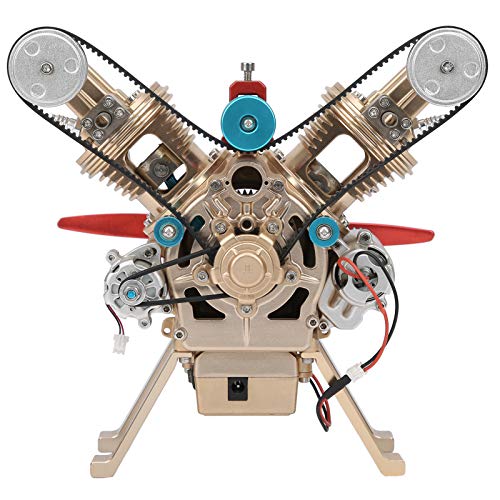You are using an out of date browser. It may not display this or other websites correctly.
You should upgrade or use an alternative browser.
You should upgrade or use an alternative browser.
Formulas for calculating the bore and stroke of a diesel engine
- Thread starter ruben
- Start date

Help Support Home Model Engine Machinist Forum:
This site may earn a commission from merchant affiliate
links, including eBay, Amazon, and others.
For an engine with a 1" diameter bore, the area of the top of the piston is pie-r-squared, so 0.785 sq.in.
Assuming a clearance of 1/16", then the volume at TDC would be 0.04906 cu.in.
For a 20:1 ratio, then the volume at BDC would be 0.98125 cu.in.
So 1.25" stroke.
My math is off somewhere.
Somebody help me.
.
Assuming a clearance of 1/16", then the volume at TDC would be 0.04906 cu.in.
For a 20:1 ratio, then the volume at BDC would be 0.98125 cu.in.
So 1.25" stroke.
My math is off somewhere.
Somebody help me.
.

Compression ratio depends on 2 factors: r (radius) and h (length)
There are 2 types of h: h1 is the piston stroke and h2 is the combustion chamber
If you choose compression ratio 20:1
From there you calculate the ratio of h1 and h2
If you choose h1 stroke then you can calculate h2 and vice versa
Note - the combustion chamber is not cylindrical so to calculate its volume you have to measure everywhere or you can measure it by filling the combustion chamber with liquid and measuring the volume of liquid in the combustion chamber
peterl95124
Well-Known Member
- Joined
- Feb 22, 2020
- Messages
- 523
- Reaction score
- 338
My "Hansen" Diesel has a stroke of 40mm, and a head space at TDC of 2mm, so ~20:1, diameter doesn't factor in, its that simple  !!! (technically its 42:2, but 40:2 is close enough for gov't work !)
!!! (technically its 42:2, but 40:2 is close enough for gov't work !)
- Joined
- Jun 24, 2010
- Messages
- 2,425
- Reaction score
- 959
My math is off somewhere.
Somebody help me.
Using your example which assumes the combustion chamber is perfectly cylindrical, the CR calculates to 21. Bore & Pi drop out of the equation so you can get the same CR value just knowing stroke (s) & clearance (h) using CR=(s+h)/h. But typically combustion chamber is domed or angled or otherwise 'non-cylindrical' so you have to compute or otherwise measure its actual volume Vc & use formula CR=(Vd+Vc)/Vc

https://en.wikipedia.org/wiki/Compression_ratio
- Joined
- Jun 24, 2010
- Messages
- 2,425
- Reaction score
- 959
(for the simplified cylindrical combustion chamber example only!) if you know CR and stroke (s), h can be determined using h =s/(CR-1).

But for a 'non-cylindrical' head it becomes a convergence type solution. Example Vc was measured directly at 0.080 in3. Stroke was iterated until the target CR of 15.0 was achieved using the same CR formula. Similarly you could define the stroke & vary the bore to converge.


But for a 'non-cylindrical' head it becomes a convergence type solution. Example Vc was measured directly at 0.080 in3. Stroke was iterated until the target CR of 15.0 was achieved using the same CR formula. Similarly you could define the stroke & vary the bore to converge.

Last edited:

$156.90 ($1.40 / oz)
Replacement Combustion Chamber Kit, Burnham V8 and V8H, 1-6 Sec, 108136-01, 1129
Lynn Manufacturing

$39.99
$49.99
Sunnytech Low Temperature Stirling Engine Motor Steam Heat Education Model Toy Kit For mechanical skills (LT001)
stirlingtechonline

$188.98
TM NEXDYNAMI RE41157 Water Pump Compatible With/Replacement For/John Deere 6200 7400 6300 6600 6500 6400 7220 7600 7200 RE41157
VIVID MARKET CORPORATION

$94.99
$109.99
AHS Woodmaster 4400 Maintenance Kit for Outdoor Wood Boiler Treatment
Alternative Heating & Supplies

$45.99
Sunnytech Mini Hot Air Stirling Engine Motor Model Educational Toy Kits Electricity HA001
stirlingtechonline

$59.99
Sunnytech Hot Air Stirling Engine Motor Model Educational Toy Electricity Generator Colorful LED (SC001)
stirlingtechonline

$99.99
$109.99
AmTech300 - Boiler Treatment Professional Strength (Rust Inhibitor For Outdoor Wood Boilers)
Alternative Heating & Supplies

$190.00
$254.99
Genmitsu CNC 3018-PRO Router Kit GRBL Control 3 Axis Plastic Acrylic PCB PVC Wood Carving Milling Engraving Machine, XYZ Working Area 300x180x45mm
SainSmart Official

$403.09
DM14 Engine Build Kit, Metal Engine Build Model Great Metal Material for Engineer for Factory
Easoger Official

$519.19
$699.00
FoxAlien Masuter Pro CNC Router Machine, Upgraded 3-Axis Engraving All-Metal Milling Machine for Wood Acrylic MDF Nylon Carving Cutting
FoxAlien Official

$99.99
AHS Outdoor Wood Boiler Yearly Maintenance Kit with Water Treatment - ProTech 300 & Test Kit
Alternative Heating & Supplies
This is one of Find Hansen's videos.
He lists a bore of 20mm, and a stroke of 40 mm, with a compression ratio of 21:1.
Obviously the clearance volume is going to have a big affect on compression ratio, and I seem to recall seeing that diesels had a relatively small clearance space.
I will see if I can match his numbers somehow.
.
He lists a bore of 20mm, and a stroke of 40 mm, with a compression ratio of 21:1.
Obviously the clearance volume is going to have a big affect on compression ratio, and I seem to recall seeing that diesels had a relatively small clearance space.
I will see if I can match his numbers somehow.
.
Seems like you are mixing your units.My "Hansen" Diesel has a stroke of 40mm, and a head space at TDC of 2mm, so ~20:1, diameter doesn't factor in, its that simple!!! (technically its 42:2, but 40:2 is close enough for gov't work !)
You are making a ratio between length in mm and volume in cubic mm.
I think it would need to be a comparison between two cubic volumes in order to calculate the ratio of minimum to maximum pressure, which I think is the definition of compression ratio ?
Edit:
Or I guess you are saying a head clearance of 2mm, not a volume, so never mind; I am a bit confused, as usual.
.
Last edited:
Looking at the two extremes, in one ideal case, where there is no clearance, the pressure will approach infinity as the piston approaches TDC.
In the other extreme, as the cylinder becomes infinitely long, the pressure approaches zero; ie: no compression is taking place.
I seem to recall that diesels use a relatively long stroke, with associated slower maximum rpm that a square engine, ie: a square engine having a bore that equaled the stroke.
Looking at a Detroit Diesel 671 engine, the displacement per cylinder is 70.93 cu in, with a 4.25" bore, and a 5" stroke, 18.7 : 1 compression ratio.
This is not nearly as long a stroke as I had thought was used.
So with a diesel, the key is the air inside the cylinder being compressed to the point where it reached the ignition temperature of diesel fuel; recalling the old thermo class days, and the PV=mrt forumla (I think is the correct forumula, or ballpark thereof).
So perhaps we can use the 671 data and work backwards to see what the clearance would have had to have been at TDC to get 18.7 : 1, and reach the ignition temperature required.
Obviously as the clearance goes down, the pressure and compression ratio go up.
So if Peter's forumula is correct, then a Detroit 671 would have a head clearance of 0.267", which seems reasonable.
.
In the other extreme, as the cylinder becomes infinitely long, the pressure approaches zero; ie: no compression is taking place.
I seem to recall that diesels use a relatively long stroke, with associated slower maximum rpm that a square engine, ie: a square engine having a bore that equaled the stroke.
Looking at a Detroit Diesel 671 engine, the displacement per cylinder is 70.93 cu in, with a 4.25" bore, and a 5" stroke, 18.7 : 1 compression ratio.
This is not nearly as long a stroke as I had thought was used.
So with a diesel, the key is the air inside the cylinder being compressed to the point where it reached the ignition temperature of diesel fuel; recalling the old thermo class days, and the PV=mrt forumla (I think is the correct forumula, or ballpark thereof).
So perhaps we can use the 671 data and work backwards to see what the clearance would have had to have been at TDC to get 18.7 : 1, and reach the ignition temperature required.
Obviously as the clearance goes down, the pressure and compression ratio go up.
So if Peter's forumula is correct, then a Detroit 671 would have a head clearance of 0.267", which seems reasonable.
.
Last edited:
Working it as a volume comparision, the total volume at BDC with a 0.267" head clearance would be 74.68 cu in.
At TDC, the volume with a 0.267" head clearance (assuming a flat head and a flat piston top, to simplify things) would be 3.7857 cu in.
The ratio would be 74:68/3.7857 = 19.7 : 1
So pretty close to 18.7 : 1, but slightly off.
.
At TDC, the volume with a 0.267" head clearance (assuming a flat head and a flat piston top, to simplify things) would be 3.7857 cu in.
The ratio would be 74:68/3.7857 = 19.7 : 1
So pretty close to 18.7 : 1, but slightly off.
.
I would not have thought that it would be as simple as a ratio of stroke to head space, but it does seem that way, reading what everyone has posted above.
.
.
Hello, I would like to know if there is a formula to calculate what diameter and stroke a diesel engine should have with a compression ratio of 20 to 1 or with a compression value of 25 bars.
I am not sure about the 25 bar, but the answer seems to be to compare the stroke to the head clearance.
.
- Joined
- Jun 24, 2010
- Messages
- 2,425
- Reaction score
- 959
The simplified s & h formulas only apply when Vc & Vd are represented as cylindrical cans. A flat top piston meets this criteria & is easy to calculate. But many combustion chambers are not shaped like simple cylindrical cans in real life, so you have to get a handle on actual volume, either measured or computed, and compute CR on that basis. The combustion chamber could be domed or asymmetrically curved in cross section. Valve faces would be a flat surfaces, maybe semi-flush or maybe slightly submerged. Ignition plugs affect volume with clearance or protuberance. The piston top may not be a simple flat or match the head section profile entirely for various reasons. The higher the CR, the more sensitive even tiny dimensional changes to head features become. I seem to recall on certain RC engines, the difference in a glow plug washer thickness was worth 0.5 CR or thereabouts.


A function in 3D drawing software allows the calculation of a volume, hence it is easy to model the combustion chamber to determine its volume, even for a complex shape...more easy than measuring it with a liquid, particularly if the engine is not yet built!
Attachments
I use the mass function in Solidworks to calculate the mass of various 3D parts, so I can calculate how much metal I will need to cast a part.A function in 3D drawing software allows the calculation of a volume, hence it is easy to model the combustion chamber to determine its volume, even for a complex shape...more easy than measuring it with a liquid, particularly if the engine is not yet built!
I can change the material to aluminum, bronze/brass, gray iron, etc.
This is very helpful in avoiding short pours, where your crucible does not hold enough metal to completely fill the mold.
The volume function is not something I thought about using.
There are a lot of features in 3D modeling programs that I don't use, but probably should be taking advantage of.
.
There appears to be a recess in the top of a Detroit Diesel 671 piston, and both the two and four valve heads for the 671 appear to be flat on the surface facing the piston.
The injector appears to be directly centered in the cylinder.
.
The injector appears to be directly centered in the cylinder.
.
Attachments
Hello Rubin,Hello, I would like to know if there is a formula to calculate what diameter and stroke a diesel engine should have with a compression ratio of 20 to 1 or with a compression value of 25 bars.
It is reasonably easy to calculate the compression ratio using a pressure gauge.
Measure the max. pressure of the cylinder then divide by 14.7 atmospheric pressure
Example; cylinder pressure measured 80-PSI divide by 14.7 (Atmos. pressure), answer 5.4:1
Hope this is of assistance
Doug Baker
Scarborough WA
peterl95124
Well-Known Member
- Joined
- Feb 22, 2020
- Messages
- 523
- Reaction score
- 338
(once again...) "Compression Pressure" and "Compression Ratio" aka "Volume Ratio" are NOT the same, the "compression ratio" is purely geometric and does not take into account thermodynamics, the actual "Pressure" after "Compression" is given by a much more complicated formula (because so much work has been done to the gas during compression, and that work shows up as additional pressure and temperature)
in addition to PV/T = const, there are these formulas PV^gamma = const, TV^(gamma-1) = const, and P^(1-gamma)T^gamma = const, and the more useful for us formulas
PR = VR ^ (-gamma), and TR = VR^(1-gamma)
where PR is pressure ratio, TR is temperature ratio, VR is volume ratio.
and gamma = 1.4 for diatomic gases like air being mostly N2 and O2,
these formulas require using temperature measured relative to absolute zero, and pressure relative to a vacuum, but if you do all the necessary conversions you'll get these numbers
20:1 974-PSI 1296-degF (or 66 Bar, and 700-degC), for STP input (1 Bar, 20-C)
the main issue with homebuilt Diesel engines is that the injector pump has to both overcome the 66 Bar cylinder pressure, and apply an additional 66 Bar for spray atomization, so a total of ~130 Bar, or ~2000 PSI, is required. a non-trivial task ! (also 974-PSI applied to a 1" piston has about 750 pounds-force on it, think about how strong the con-rod has to be and how much force the crankpin and crankshaft bearings have to endure, then maybe double those numbers for after ignition).
(PS (once again...), the 700-degC is a temperature where ignition is guaranteed, the "flash point" or what ever else temperature you'll see on the internet for various fuels is totally irrelevant as it is a temperature below which it is guaranteed that ignition will NOT occur, and above which ignition only *might* occur, so it is a "safe handling" temperature, not a guaranteed ignition temperature)
in addition to PV/T = const, there are these formulas PV^gamma = const, TV^(gamma-1) = const, and P^(1-gamma)T^gamma = const, and the more useful for us formulas
PR = VR ^ (-gamma), and TR = VR^(1-gamma)
where PR is pressure ratio, TR is temperature ratio, VR is volume ratio.
and gamma = 1.4 for diatomic gases like air being mostly N2 and O2,
these formulas require using temperature measured relative to absolute zero, and pressure relative to a vacuum, but if you do all the necessary conversions you'll get these numbers
20:1 974-PSI 1296-degF (or 66 Bar, and 700-degC), for STP input (1 Bar, 20-C)
the main issue with homebuilt Diesel engines is that the injector pump has to both overcome the 66 Bar cylinder pressure, and apply an additional 66 Bar for spray atomization, so a total of ~130 Bar, or ~2000 PSI, is required. a non-trivial task ! (also 974-PSI applied to a 1" piston has about 750 pounds-force on it, think about how strong the con-rod has to be and how much force the crankpin and crankshaft bearings have to endure, then maybe double those numbers for after ignition).
(PS (once again...), the 700-degC is a temperature where ignition is guaranteed, the "flash point" or what ever else temperature you'll see on the internet for various fuels is totally irrelevant as it is a temperature below which it is guaranteed that ignition will NOT occur, and above which ignition only *might* occur, so it is a "safe handling" temperature, not a guaranteed ignition temperature)
It is based on absolutely perfect conditions, which in reality are never achieved.20:1 974-PSI 1296-degF (or 66 Bar, and 700-degC), for STP input (1 Bar, 20-C)
Flash point is different from auto ignition temperature !!!!(PS (once again...), the 700-degC is a temperature where ignition is guaranteed, the "flash point" or what ever else temperature you'll see on the internet for various fuels is totally irrelevant as it is a temperature below which it is guaranteed that ignition will NOT occur, and above which ignition only *might* occur, so it is a "safe handling" temperature, not a guaranteed ignition temperature)
Similar threads
- Replies
- 5
- Views
- 2K


























































